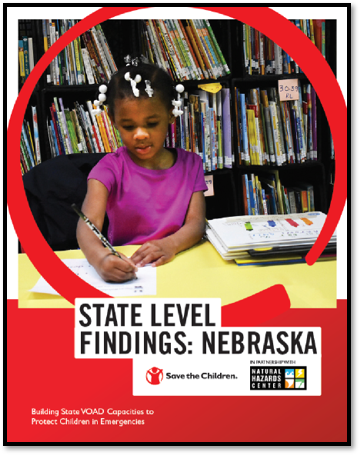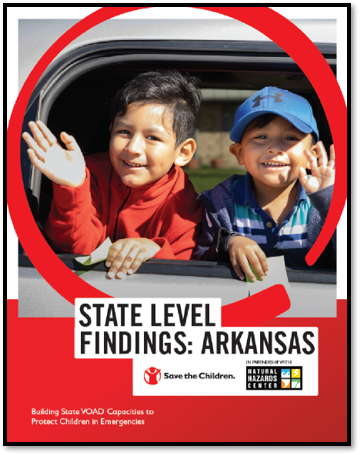Save the Children
An Evaluation of State Voluntary Organizations Active in Disaster (VOAD) Capacities to Protect Children in Emergencies Project

Project Summary
In partnership with Save the Children U.S. Programs, the Natural Hazards Center evaluation research team has completed the “Building State Voluntary Organizations Active in Disasters’ (VOAD) Capacities to Protect Children in Emergencies Project.” Children and youth, while representing roughly a quarter of the U.S. population, remain under-represented and generally overlooked in disaster planning and research. The overall purpose of this project was to address this gap by capturing how state-level VOADs prioritize the unique needs of children in their emergency response and recovery efforts and opportunities for capacity-building to address these needs before, during, and after disaster.
To that end, the Natural Hazards Center team conducted a formative outcome evaluation of state VOADs’ knowledge of and ability to address children’s needs in emergencies. Our work took place between 2018 and 2020 and focused within two Midwest states, Arkansas and Nebraska, to assess the proof of concept behind the project model. Throughout this period, we developed data collection instruments, as well as tools and resources for AR and NE VOADs, including participatory asset mapping exercises and interactive GIS maps, to assist in identifying areas for improvement and collaboration at the state VOAD level. Finally, we synthesized our findings to create five state-level indicators that states can use to measure and improve their readiness to address children’s needs in the context of emergencies.
Please click on the images below to download the Final Evaluation Report and the State Level Findings for Nebraska and Arkansas. Learn more about the evaluation’s key findings, recommendations, and associated tools and resources in the sections that follow.
What Challenge Did This Project Address?
Multiple actors and entities are critical to ensuring that children’s needs are represented in disaster planning and that necessary resources are mobilized leading up to, during, and after disaster to reduce negative outcomes for children. The National Commission on Children and Disasters (NCCD), an independent, bipartisan body established by Congress and the President in the wake of Hurricane Katrina, issued a final report in 2010 that identified major gaps in disaster preparedness, response, and recovery for children (NCCD 2010). In 2015, Save the Children commissioned research to measure progress toward achieving and addressing 81 recommendations that the NCCD identified in its final report. This research revealed that 79% of the recommendations remain unfulfilled. More specifically, only 17 of the initial 81 recommendations had been fully met or implemented in the decade following Hurricane Katrina; 44 were still in progress; and 20 remained unaddressed (Save the Children 2015).
In 2018, Save the Children commissioned the project, “Building State VOAD Capacities to Protect Children in Emergencies,” to assist state-level organizations and emergency managers in implementing the NCCD recommendations. Once the focal states were identified, the Natural Hazards Center was selected to lead the evaluation research and to support Save the Children in achieving the four major project goals:
- Increase VOAD and emergency management knowledge and awareness of children’s needs and strengthen their ability to meet children’s needs in emergencies;
- Influence increased prioritization of children’s needs in VOAD and emergency management organizations through representation and shifts in organizational culture;
- Assess the proof of concept behind the project model in two Midwest states using a formative outcome evaluation; and
- Establish basic state-level indicators to measure a state’s progress in addressing key recommendations by the NCCD.
Key Findings and Recommendations
This project involved multi-method research in the focal states of Arkansas and Nebraska and in collaboration with members of VOADs, emergency management, and child serving organizations in both states. The evaluation team conducted participatory asset mapping exercises, survey research, secondary data analysis and GIS mapping, and a social network analysis survey.
Key Findings
- VOADs are likely to respond to children and families in a disaster. Our initial survey revealed that more than two-thirds of VOADs in Arkansas and Nebraska would assist children and/or families during a catastrophic or low-attention disaster.
- VOADs are not fully ready to meet children’s needs in a disaster. The survey also showed, however, that roughly half of these organizations have not received training related to protecting children in emergencies and more than half have not written plans or protocols to support children in the context of disaster.
- VOAD organizations face a number of constraints that impede their ability to collaborate and appropriately address children’s disaster-specific needs. In both states, “insufficient funding” was the most reported concern or challenge that affected organizations’ ability to respond effectively to disasters. Other frequently reported constraints included challenges with “maintaining high quality staff/volunteers,” “insufficient equipment or other material resources,” and difficulties associated with “inter-organizational coordination.”
- Rural areas are under-represented in state-level VOAD structures and therefore children living in these areas are likely to be underserved during times of disaster. Participatory asset mapping activities in both states revealed critical gaps in service provision for rural areas, with metropolitan areas receiving the most attention in terms of organizational representation and resources. Analysis of secondary data and interactive GIS maps also revealed a dearth of child-serving organizations in rural areas, despite high levels of social vulnerability among children and their families within these areas.
- There are many unrealized opportunities for the exchange of child-specific resources among organizations within VOADs. According to findings from the social network analysis, very few VOAD member and affiliate organizations are engaged in exchanging resources or collaborating in efforts to meet children’s needs in a disaster. The lack of established networks within VOADs, especially in regards to child-specific resources, may hamper these organizations’ ability to provide and coordinate child-specific services to communities affected by disaster.
Recommendations
Based on these findings, this report recommends adopting the following five state-level indicators to help assess and monitor state progress toward inclusive VOADs that are prepared to meet children’s needs:
- At least two child-serving organizations are involved and active participants in the state-level VOAD.
- At least one state VOAD member has received formal training in child-specific needs in disaster and that member is regularly invited to speak about children’s needs at VOAD meetings.
- The state-level VOAD has a plan to identify and address the specific needs of children during disaster.
- The state-level VOAD has collected child-specific data within their state to identify the number of children, their geographic location, their hazard exposure, and potential vulnerabilities (e.g., low-income children, non-English speaking children and families, children in foster care, etc.).
- The state-level VOAD holds semi-annual meetings that assess available child-focused assets and identify areas for improvement within the VOAD.
Additional Project Deliverables
In addition to the final reports, the Natural Hazards Center team produced a number of other deliverables for this project, including survey instruments, interactive GIS maps, a participatory asset mapping protocol, and social network analyses. Below we highlight two of these deliverables: The Interactive-GIS Maps and the Social Network analysis. You can find a full description of the project deliverables in the Final Report, linked above.
Interactive GIS-maps
We incorporated U.S. Census data and Centers for Disease Control (CDC) social vulnerability data to build two interactive GIS maps for Arkansas and Nebraska. For each state, layers for these interactive maps include: 1) children’s hospitals, 2) food banks, 3) child-serving organizations, 4) emergency coordinator contacts, 5) CDC social vulnerability index by census tract, and 6) Federal Emergency Management Agency (FEMA) disaster declarations from 1964-2015. These maps provide compiled resources and information for state VOADs, their partners, as well as government and social service organizations, which are a useful tool for illustrating gaps in child-focused service provision and identifying areas for improvement.
Interested readers can try out the fully-active GIS maps for Arkansas and Nebraska below. Click here for an explanation of the map icons and other tips for using this tool.
Arkansas
Nebraska
Social Network Analysis
A central objective of this project was to gain a deeper understanding of existing connections and opportunities for collaboration across VOAD member and partner organizations in Arkansas and Nebraska. To achieve this, our evaluation team developed a novel social network analysis (SNA) survey to measure the degree to which VOAD member organizations in Arkansas and Nebraska interact, exchange resources, and collaborate in shared efforts. In particular, we focused on the extent to which child-serving organizations and organizations with child-specific knowledge and training were represented within Arkansas and Nebraska VOAD networks.
Our SNA analysis drew upon data from 34 Arkansas and 43 Nebraska organizations and revealed that very few organizations engaged in meaningful interactions and frequent contact with each other. Such limited interaction could negatively affect or impede the provision of services to affected communities, specifically children. Moreover, child-specific resource exchange networks in both states were among the least connected networks. Many organizations reported no engagement in child-specific resource exchange networks.
Readers can find a full discussion of our Social Network Analysis methods and findings in the Full Report and State-Level Appendices.
Natural Hazards Center Research and Evaluation Team
Principal Investigator: Lori Peek, Natural Hazards Center
Co-Principal Investigator and Research Evaluation Lead: Jamie Vickery, Natural Hazards Center and University of Washington
Co-Principal Investigators: Mason Mathews, Arizona State University and Haorui Wu, Dalhousie University
Contributers: Luther Green, Nnenia Campbell, Jennifer Tobin, Erica Schelly, Katie Murphy, Helen Gardner, Jolie Breeden, Jeffrey Gunderson, Natural Hazards Center


